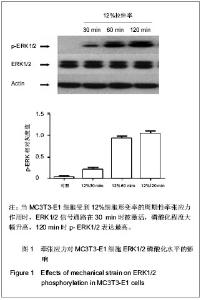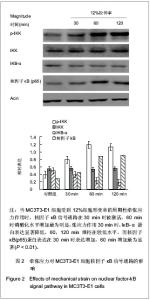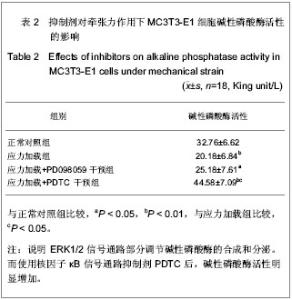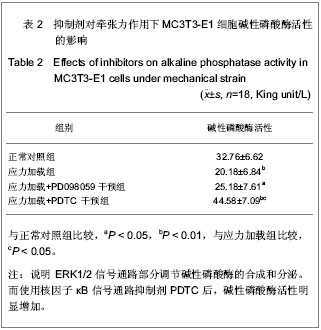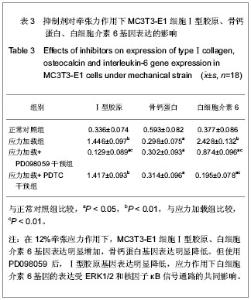| [1] Tang L, Lin Z, Li YM. Effects of different magnitudes of mechanical strain on osteoblasts in vitro. Biochem Biophys Res Commun. 2006;344(1):122-128.[2] Papachroni KK, Karatzas DN, Papavassiliou KA, et al. Mechanotransduction in osteoblast regulation and bone disease. Trends in Molecular Medicine.2009; 15:208-216.[3] Chang J,Wang Z,Tang E,et al. Inhibition of osteoblastic bone formation by nuclear factor-kappaB. Nat Med.2009;15(6): 682-689.[4] 李永明, 王华, 张晓东, 等.多通道细胞牵张应变加载系统的建立及应用[J].生物医学工程学杂志,2012,29(1):93-96.[5] Chen W, Ma Y,Ye H,et al.ERK1/2 is involved in cyclic compressive force-induced IL-6 secretion in MLO-Y4 cells. Biochem Biophys Res Commun. 2010;401(3):339-343.[6] Kanno T, Takahashi T, Tsujisawa T, et al. Mechanical stress-mediated Runx2 activation is dependent on Ras/ERK1/2 MAPK signaling in osteoblasts. J Cell Biochem. 2007;101:1266-1277.[7] Jackson RA, Kumarasuriyar A, Nurcombe V,et al. Long-term loading inhibits ERK1/2 phosphorylation and increases FGFR3 expression in MC3T3-E1 osteoblast cells. J Cell Physiol 2006;209:894e904.[8] Young SR, Gerard-O'Riley R, Harrington M,et al. Activation of NF-κB by fluid shear stress, but not TNF-α, requires focal adhesion kinase in osteoblasts. Bone.2010;47(1): 74-82.[9] Soysa NS, Alles N.NF-kappaB functions in osteoclasts. Biochem Biophys Res Commun. 2009;378(1):1-5.[10] Liu J, Zou L, Zheng Y,et al. NF-kappaB response to mechanical strains in osteoblast-like cells, and lighter strains create an NF-KB response more readily. Cell Biology International, 2007;31(10):1220-1224.[11] Sanchez C, Gabay O, Salvat C, et al. Mechanical loading highly increases IL-6 production and decreases OPG expression by osteoblasts. Osteoarthritis Cartilage.2009; 17(4):473-481.[12] Agarwal S, Long P, Seyedain A,et al. A central role for nuclear factor-kappa B pathway in the anti-inflammatory and proinflammatory actions of mechanical strain. FASEB J. 2003;17(8):899-901. |
